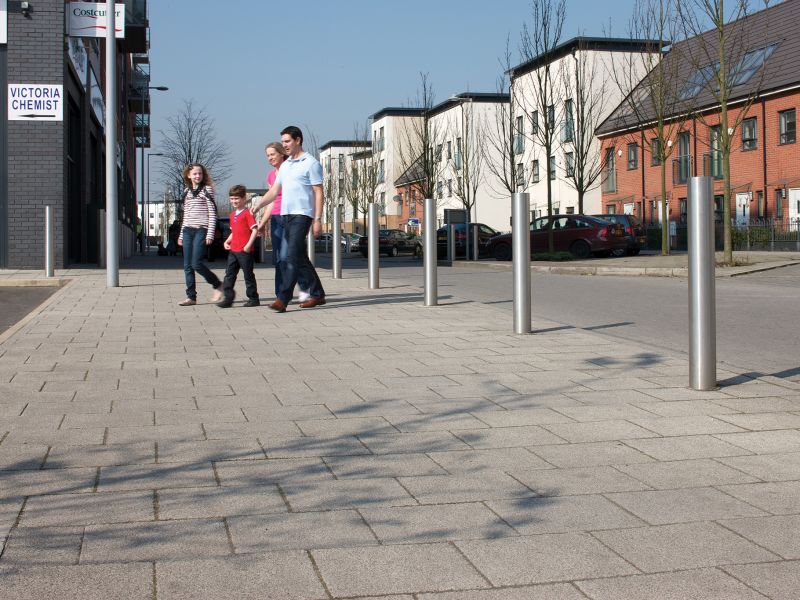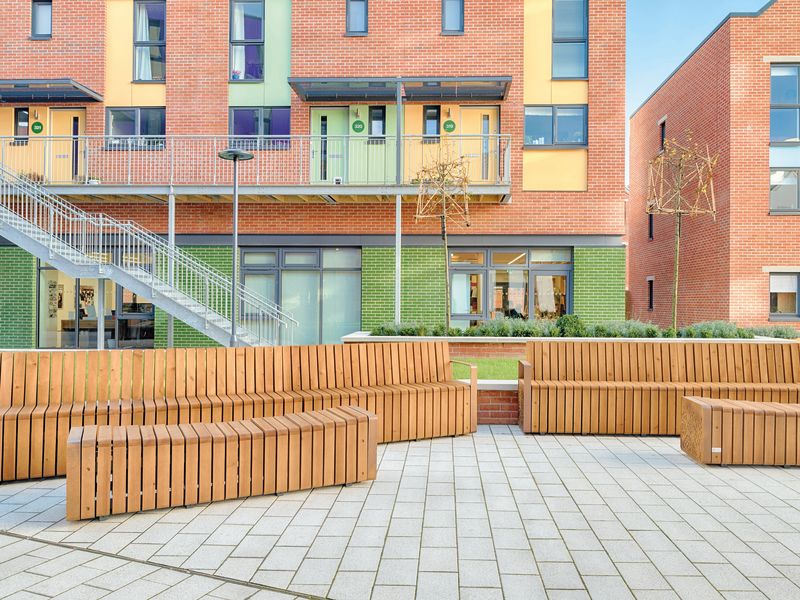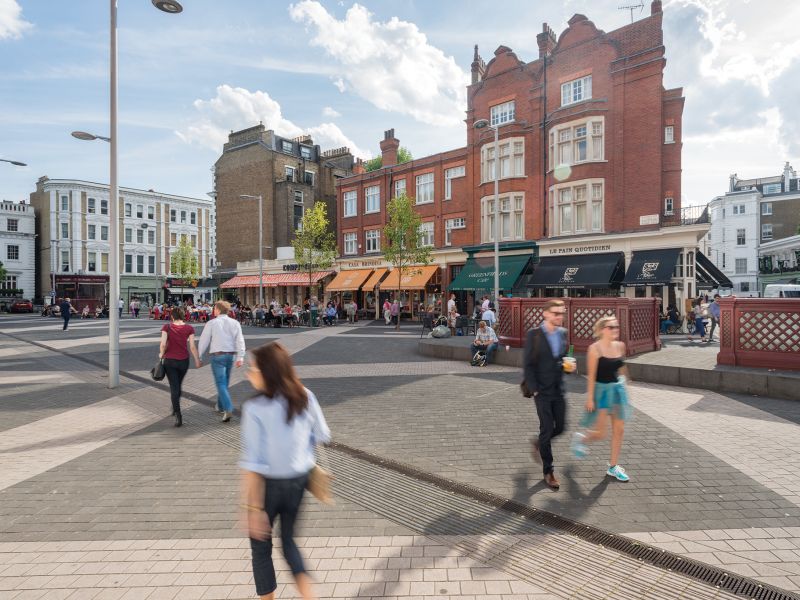Blog
Much has been written about the rise of active travel and the long-lasting impact of the pandemic on placemaking. As the world retreated to stay safe, people’s individual worlds got smaller – less travel meant more exploration of local areas and a sense of neighbourhood spirit returned to communities where it had been lacking.
As the gears shift again, it’s clear that whilst people are embracing a return to ‘normality’ there is also a huge appetite for change. Commuting time became workout time; long journeys for a day out were exchanged for throwing open the front door and picking a different path around the neighbourhood. If human behaviour has changed forever, how can planning policy and urban design catch up? Landscapes need to work harder than ever before – but what do they need to aim for? In this article we’re going to take a look at the concept of the 20-minute neighbourhood, share some inspiration from other countries and look at how this unique approach to planning and design impacts on the landscape which surrounds it.
What is a 20-minute neighbourhood?
A 20-minute neighbourhood is a well-connected and compact area where everything people need for their daily lives can be found within a 20 minute walk. The phrase was coined after an Australian study showed that 20 minutes in the maximum time that people will walk to meet their daily needs. In Paris they refer to it as the 15-minute city.
But whilst the name may be reasonably new, the concept is not. Experienced planners and landscape designers will be familiar with the work of Ebenezer Howard in the late 19th Century, from whom the Garden City model of development was born. Whilst there are many similarities between these two concepts, there is a wide acceptance that the 20-minute neighbourhood has more fluidity and flexibility – essential in today’s changing world.
In a detailed 20-minute neighbourhood guide, the TCPA, with Sport England, have been working with partners including Sustrans, Design Council, Fields in Trust, CLES, to identify a number of characteristics for an area to be defined in such a way;
- Diverse and affordable homes
- Well connected paths, streets and space
- Schools at the heart of communities
- Good green spaces in the right places
- Local food production
- Keeping jobs and money local
- Community health and wellbeing facilities
- Be a place for all ages.
What are the benefits of better connected and more compact neighbourhoods?

Some of the benefits of a more compact community mirror those positives that have been drawn from the pandemic;
- A healthier lifestyle with more walking and cycling
- Lower emissions due to less cars and public transport
- Reduced loneliness and increased social interaction as communities engage and connect more regularly
An increase in people working from home, or commuting within their neighbourhood, also creates more locally accessible jobs – the sandwich shops from city centres migrate to suburban corners, childcare settings become less about motorway connections and more about walking distances. Access to employment locally, as well as health amenities is thought to be a good route to help to tackle inequalities – and by co-locating facilities there is better collaboration and decision making. This has been seen in Melbourne Australia, where a 20-Minute Neighbourhood Pilot Program has resulted in a place based approach to planning with co-location hubs that provide a multitude of services and facilities for the community.
How does the 20-minute neighbourhood affect landscape design?
 Bristol Paintworks features a range of nature inspired seating areas in green spaces between residential and work spaces
Bristol Paintworks features a range of nature inspired seating areas in green spaces between residential and work spaces
Green space
Whilst space is at a premium in some parts of the country, the element of ‘compact’ should not always equate to squashing more into a smaller space. For a community to grow and thrive there needs to be green space, room to play and attractive routes to walk, run and cycle along. Active travel measures have a part to play in this – defining cycle lanes amongst walking routes gives encouragement to use a bike, tactile paving makes streets more navigable for partially sighted and mobility impaired users, helping to make everyone feel safe to be out regardless of ability and age.
Accessible outdoor areas
The opportunity to socialise outside is a must – if people are travelling less for leisure they need to be able to find it close to home. Well landscaped spaces with places to rest, shelter and congregate will become key to an area’s success – designs should ensure people feel safe night and day, with good lighting and open walkways. For families, elements of fun should be considered – water features such as those in Letchworth City Garden will provide a focal point in warmer weather.
Connectivity
If a 20-minute neighbourhood seeks to improve connectivity then it must be a key consideration for the landscape design. How can the designated spaces in which we live, work and play be inter-twined and flow together? No longer can an individual piece of landscape design be considered in isolation, but rather how it joins seamlessly into its surrounding community. Accessibility in respect of the above is key too – pedestrian and cycle ways need to be well planned to allow residents to transition between business and social activities. If neighbourhoods are to feature more mixed-use developments that combine offices, residential, retail and public realm, then the hard landscaping can act as a place-marker for different functions of that development.
Built-in resilience
Authorities and developers want to respond to changing behaviours by designing considered, well-balanced places but they also need to be sustainable. Neighbourhoods at risk of flooding need to be protected with the correct sustainable drainage solution to ensure communities can continue to function during bad weather. Thought should also be given to locations where extra protection might be needed from vehicles or potential terrorism, this can be delivered as protective street furniture to ensure residents feel safe not scared.
How could this concept support the growth of affordable housing?
With a nation in need of more affordable homes, the 20-minute neighbourhood could be a step in the right direction. Those that are in favour of the concept accept there is a risk of gentrification and it’s clear that planners and policy makers must seek to avoid it in some cases, by making affordable housing a central part of the plan. But when it comes to a diverse range of homes to suit different family types and an increase in well-connected affordable properties, local authorities are already trying hard to make it happen. The London Housing Zones project is one such example, set to create 30 new housing areas across the city with a total of 770,000 new homes; a third of which will be affordable. A key component of a number of these projects is connectivity – giving residents all that they need within a short walk – space to work, rest and play in a landscape that is attractive, safe and practical.
Further insight into the 20-minute neighbourhood concept
 London’s Exhibition Road was transformed in 2011 to create a space where pedestrians and vehicles co-exist equally
London’s Exhibition Road was transformed in 2011 to create a space where pedestrians and vehicles co-exist equally
Arup’s City Living Barometer
In early 2021 Arup conducted a survey of 5,000 residents across London, Paris, Madrid, Berlin and Milan. The survey used the 15-minute city concept to roughly assess the liveability of each city. People were asked how long it took them to walk or cycle to certain amenities, and whether they had considered leaving their city during the pandemic. What stood out in the results was that, at 23.5 minutes, Londoners claim to have to travel the furthest to access all that they need and 50% of them felt it was too far. Parks and green spaces were not accessible to all and the report recommended that “we need to look to re-use existing or outdated infrastructure such as car parks, school grounds or community hubs for neighbourhood activities after hours.” Recommendations in the report include improving walkability within areas, using modular parklets where there is no green space and re-using existing infrastructure such as school grounds or car parks for different purposes after hours. The latter idea is one that has been successfully adopted in Paris, as we share below.
Paris – Europe’s first 15-minute city
Since 2014 Paris has successfully overhauled its transport culture by banning high-polluting vehicles and closing major arteries to private cars. The focus is now on creating a ‘city of proximities’ which will make travel easier, public services more accessible and potentially change work places and the way culture is accessed. The authorities have already created hundreds of smaller green spaces to improve accessibility, these include over 40 school playgrounds that have become “oasis yards”. Mayor Anne Hidalgo wants every street in the city to have a cycle lane by 2024 and plans are afoot to remove over 60,000 on-street parking spots in favour of green spaces, allotments and playgrounds.
A BBC article suggests that the city’s planning model will not only change Paris itself but also act as a blueprint for others to follow, citing benefits such as stronger communities and more happiness. What works in Paris might not entirely work in London, Liverpool or Leeds but it’s clear from their progress to date that there are elements that can be mimicked here and initiatives that could be tested with communities in this country.
Marshalls offer unrivalled quality across a range of housebuilder products and hard landscaping materials
Whether you’re working on new housing schemes, multi-use developments or public spaces, your projects need to be built sustainably and built to last. Marshalls offers a wide range of hard landscaping materials as well as a large number of housebuilder products, all to the high quality and specification that you would expect from a market leading brand.
If you’re looking for more inspiration, our commercial case studies provide inspiration for a range of schemes, including pedestrianisation projects, public realm improvements and retail and leisure developments.








